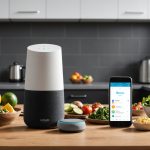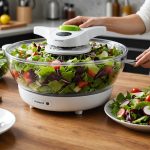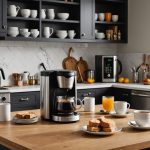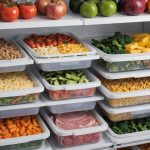Understanding Chest Freezer Temperatures
When it comes to chest freezer temperatures, maintaining the right level is crucial for optimal food storage optimization. The ideal temperature for food preservation in a chest freezer is -18°C (0°F). This temperature helps ensure that food remains safe and retains its quality over time.
Temperature fluctuations can drastically impact food quality. Frequent changes in temperature can lead to freezer burn, which affects the taste and texture of stored food. It’s essential to keep your freezer at a consistent temperature to avoid these issues.
Also read : The complete handbook for choosing a soft salad spinner that keeps delicate greens intact
Recommended Temperature Settings for Various Types of Food
- Meat and Poultry: Should be stored at -18°C (0°F) for long-term preservation.
- Vegetables and Fruits: These items also benefit from the same temperature, though blanching before freezing can enhance the retention of their nutritional content.
- Prepared Meals and Baked Goods: Consistent freezing at the recommended temperature ensures their texture and flavour are preserved when thawed.
Keeping an eye on your chest freezer temperatures not only supports food storage optimization but also aids in reducing waste and maintaining efficiency. Investing in a good thermometer can help monitor temperatures and alert you to any fluctuations.
Best Practices for Organizing a Chest Freezer
Efficient chest freezer organization can save you time and reduce food waste. First, employing storage tips like using clear containers can make locating items easier. Transparent bins allow for quick visual checks, reducing the time the freezer is open, thus maintaining stable temperatures.
Have you seen this : Elevate your salad game: choosing the ideal chopper for quick and uniform preparation
Labelling is another vital component. Clearly marked labels indicating the contents and freezing date aid in managing your inventory and ensure effective resource use, which aligns with the First In, First Out (FIFO) method. This practice involves using older items before newer ones, reducing the likelihood of food spoilage.
Strategic placement of foods can also optimize storage. Heavier, bulkier items should be placed at the bottom to create a stable base, with smaller, regularly-used items on top for easy access. This practice not only maximizes storage space but also helps maintain an even distribution of cold air throughout the freezer.
Incorporating these simple food storage tips into your routine will enhance your freezer’s efficiency and ensure food items are well-preserved. Maintaining an organized chest freezer contributes directly to achieving optimal food storage optimization.
Troubleshooting Common Temperature Issues
Fluctuating chest freezer temperatures can lead to significant problems. If you notice ice cream becoming too soft or meats displaying freezer burn, these are signs of improper temperature management. Identifying the root cause is crucial to finding a solution.
Common causes of temperature variations include a door not sealing properly, overloading the freezer, or a malfunctioning thermostat. Ensuring the door is tightly sealed and that there is adequate space for air circulation can prevent many issues.
To maintain efficiency and restore ideal temperatures, consider the following solutions:
- Regularly check and clean the door seal to ensure it closes correctly.
- Avoid overstocking, which can block airflow.
- Invest in a freezer alarm to alert you of temperature changes.
For more accurate temperature management, employing an external thermometer can provide real-time readings, helping you monitor and adjust settings accordingly. Also, practising regular maintenance, like cleaning the compressor coils, can prolong your freezer’s life.
By addressing these common problems and implementing these solutions, your freezer can consistently support your food storage optimization efforts, ensuring safe and high-quality preservation of your food items.
Safely Freezing Different Food Types
Proper food freezing guidelines are crucial for maintaining taste, texture, and nutritional quality. Ensuring the correct methods are used for each food type can also help achieve optimal freezer safety practices.
Freezing Vegetables
Blanching vegetables before freezing is recommended as it can enhance flavour preservation and helps in retaining nutrients. A brief boil or steam followed by an ice bath halts enzyme actions, maintaining the colour and texture while ensuring freezer safety practices.
Freezing Meats
For meats, airtight packaging is essential. Utilize vacuum sealing or heavy-duty freezer bags to minimize exposure to air and reduce the risk of freezer burn. These food freezing guidelines ensure meats maintain their flavour and quality over time.
Freezing Prepared Meals
Preserve the quality of prepared meals by allowing them to cool thoroughly before freezing. Use portion-sized, airtight containers or bags to prevent moisture loss. Labelling these containers with contents and freezing dates adds another layer of practicality to your freezer safety practices.
By following these food freezing guidelines, individuals can effectively manage their chest freezer contents while maintaining optimal quality. Implementing these practices ensures food safety and longevity, providing peace of mind in food storage.
Visual Aids and Examples
Incorporating visual guides into your chest freezer management can simplify food storage optimization. Infographics are an excellent way to display ideal temperature ranges and illustrate how maintaining consistent temperatures impacts food quality. For instance, visual guides can help underscore the importance of keeping the freezer at -18°C (0°F), as deviations can accelerate spoilage.
Food storage examples presented through example layouts can aid in maximizing your chest freezer’s space. Such visuals often depict strategic placements, showcasing how to organise heavier, bulkier items at the bottom and frequently used products on top. This ensures an easy-access and balanced environment, maintaining even cold air distribution.
For an efficient guide, charts can be employed to compare freezing times for different food types. These help users understand appropriate durations necessary for each category, ensuring safety and quality. Employing such aids visually conveys practical knowledge that abstract explanations might miss, thereby enhancing understanding and decision-making.
Use these visual aids not merely as passive references but as active resources to guide your daily usage. By transforming abstract guidelines into engaging graphics, you’ll be supported in achieving a well-organised and efficiently managed freezer space.
Frequently Asked Questions
Freezer FAQs can address common misconceptions about freezing food, which often lead to improper practices. One frequent misconception is that all food can be stored indefinitely in a freezer without affecting its quality. While freezing halts bacterial growth, it doesn’t stop the gradual degradation of food over time. Meats, for instance, are best consumed within 6-12 months for food storage optimization.
When it comes to defrosting, a common food storage question is about the safest method. The safest practice is to thaw items in the refrigerator, reducing the risk of bacterial growth. This slow method ensures food remains at a safe temperature.
Many inquire about the best tools and gadgets to monitor freezer temperature. Investing in a reliable thermometer or a digital temperature monitor is recommended for effective temperature management. These tools help ensure your freezer maintains the recommended -18°C (0°F), crucial for long-term food quality.
For further clarity, integrating these solutions into your food storage routine not only addresses prevalent freezer FAQs but also promotes an efficient and safe freezing environment. This, in turn, provides peace of mind in ensuring your food remains in optimal condition.











